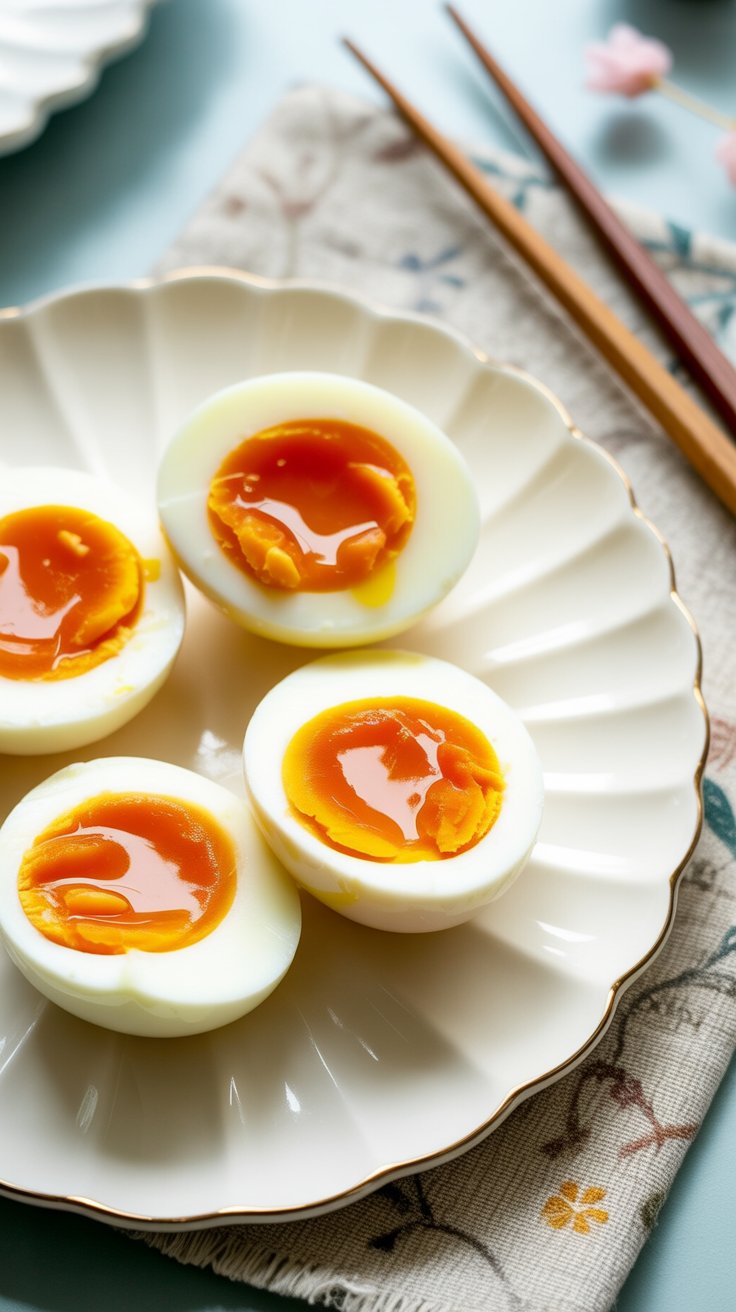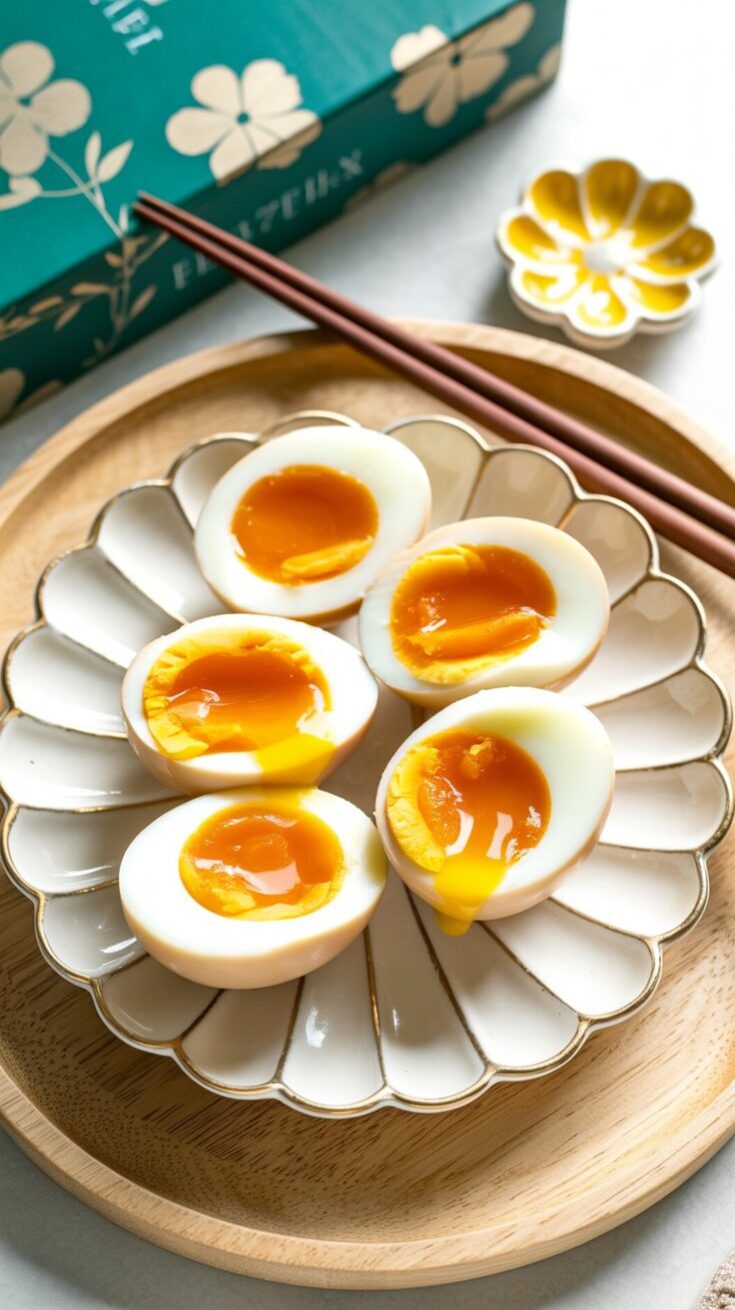You know those jammy, savory, glossy eggs that sit so perfectly on top of a bowl of steaming ramen? Yeah, those. I still remember the first time I had one at a little ramen joint tucked away near a train station. The yolk was like golden custard, the outside carried a deep, soy-rich flavor, and I honestly forgot I was even eating an egg. That’s when I knew I had to learn how to make these at home.

Turns out, making ramen eggs—known in Japan as Ajitsuke Tamago—is actually pretty simple. And once you get the timing right, you’ll start sneaking these into everything from your noodles to your salads.
So, What Exactly Are Ramen Eggs?
Ramen eggs are soft-boiled eggs marinated in a soy-based mixture until they soak up all that sweet, savory, umami goodness. The yolks stay custardy—somewhere between jammy and molten—and the whites turn slightly amber from the marinade. They’re most famous as a ramen topping, but trust me, I’ve eaten them straight from the fridge as a snack more times than I’d like to admit.
I also love tucking them into lunch boxes, slicing one up over a bowl of warm rice with some chili crisp, or adding them to a sandwich with grilled chicken and fresh greens. You’d be surprised how versatile they are once you’ve got a batch sitting in the fridge.
What You’ll Need to Make These at Home
You only need five ingredients, and most of them might already be in your pantry.
-
Eggs – Go for the best quality you can find. Fresh eggs are harder to peel, so I actually use eggs that are a few days old.
-
Soy sauce – I use a regular Japanese-style soy sauce. You want that salty, umami depth here.
-
Mirin – A sweet rice wine that balances the soy. Adds a nice glaze too.
-
Sake or water – If you have sake, use it. If not, water works just fine.
-
Sugar – Just a touch brings it all together.
You can jazz up the marinade with garlic, chili flakes, or ginger if you like, but honestly, I keep it basic most of the time. The simplicity is what makes them so satisfying.
A Little Note on the Updated Method
I used to make ramen eggs using water instead of sake. But once I started using sake—and simmering it just a bit to cook off the alcohol—it made a subtle difference. The eggs tasted deeper, smoother, a little rounder in flavor. It was one of those small tweaks that made me go, “Oh, okay… this is better.”
I also add a bit of sugar now. Just enough to balance the salt and bring a little sweetness to the outer layer of the egg white. If you’re avoiding alcohol, no worries—water still gives you a delicious result.

Step-by-Step: How I Make the Best Ramen Eggs
Here’s a quick breakdown of the process I follow. It’s simple once you’ve done it once or twice.
1. Make the marinade
Simmer soy sauce, mirin, sake (or water), and sugar for just a minute to dissolve everything and mellow the sake. Let it cool before adding the eggs.
2. Boil the eggs
Bring water to a gentle boil. Take your refrigerated eggs and lower them gently into the water using a spoon or strainer.
Set a timer for 7 minutes as soon as the first egg hits the water. That’s the sweet spot for that jammy yolk. I usually cook four eggs at once, so by the time I’ve dropped the last one in, I adjust and shave off 30 seconds if needed.
3. Ice bath
Once the timer’s up, straight into an ice bath. Don’t skip this. It stops the cooking and makes peeling way easier. I even peel them in the ice water sometimes—the water slips into the shell membrane and helps the shell come off in bigger pieces.
4. Marinate overnight
Once peeled and cooled, drop the eggs gently into the marinade. I use a zip-top bag or a small container where the eggs are fully submerged. Let them sit in the fridge for at least 6 hours or overnight.
If they sit longer than 24 hours, they’ll get saltier. I like pulling them out the next day and enjoying them fresh.
Helpful Tips from My Kitchen
-
Use older eggs if possible. They’re easier to peel, plain and simple.
-
Use a strainer spoon to lower eggs into boiling water to prevent cracking.
-
Keep the marinade simple and let the soy-mirin flavor do its thing.
-
Don’t skip the ice bath. I’ve tried. It didn’t go well.
-
Make extra. You’ll always wish you had more.
How Long Do They Last in the Fridge?
These eggs stay good for about 3 to 4 days in the fridge. I usually take them out of the marinade after the first 24 hours to avoid over-salting. Just store them in an airtight container and enjoy them cold or at room temp.
If you’re planning ahead for guests or ramen night, you can boil and marinate them two days in advance, then keep them chilled.

How I Like to Serve Ramen Eggs
Of course, they’re incredible in a hot bowl of ramen. But honestly, I use them in so many other ways:
-
Sliced over miso ramen or vegetarian broth
-
With a bowl of Japanese curry and rice
-
On top of a slice of avocado toast
-
Tossed into a rice bowl with leftover stir-fry
-
Packed into a lunchbox for school or office days
-
Even just eaten as-is, with a little chili oil or furikake sprinkled on top
They’re a little luxurious and totally comforting, whether you’re making a bowl of noodles at midnight or adding a soft egg to your weekend brunch plate.
Perfect Ramen Eggs (Ajitsuke Tamago)

If you've ever swooned over those glossy, golden-yolked eggs nestled in a bowl of ramen, you're not alone. These Japanese soft-boiled beauties, also called Ajitama, are flavorful, tender, and surprisingly easy to make at home.
Ingredients
- 4 large eggs (cold from the fridge; slightly aged eggs peel easier)
- ¼ cup soy sauce
- ¼ cup sake (or substitute with water if you prefer)
- ¼ cup mirin
- 1 teaspoon sugar
Instructions
- Start with the marinade. In a small saucepan, mix soy sauce, mirin, sake, and sugar. Warm it up over medium heat until it starts to boil gently, stirring to dissolve the sugar. Let it simmer for about a minute, then turn off the heat and let it cool to room temperature.
- Meanwhile, get your eggs ready. Bring a pot of water to a full boil. Lower the cold eggs in gently using a slotted spoon or ladle—don’t just drop them in, or they’ll crack. The second your first egg hits the water, set a timer for 7 minutes.
- Keep the boil gentle—no wild bubbling—and if you’d like the yolks perfectly centered, you can softly roll the eggs around during the first couple of minutes. Once the timer goes off, transfer the eggs straight into a bowl of ice water. Let them cool completely for at least 15 minutes. This not only stops the cooking but also helps with peeling.
- When you're ready to peel, tap the wide base of the egg to crack it, then peel upwards. Dip it back in the ice water if the shell sticks—makes things easier.
- Place the peeled eggs into a zip-top bag and pour in the cooled marinade. Press out as much air as you can, and seal it snugly so the eggs stay submerged. Use a clip or rubber band to hold the bag just above the eggs if needed. Pop it in the fridge and let them marinate for 8 hours or overnight.
Notes
- When you're ready to serve, slice the eggs lengthwise with a thread, cheese slicer, or fishing line for that perfect clean cut. They're amazing on top of ramen, but also lovely as a snack with some furikake or a pinch of Japanese chili powder. I’ve even added them to avocado toast!
- If you prefer them warm, just soak the bag in a bowl of warm water for a few minutes before serving.
- Keep these eggs in the fridge at all times. They taste best within 12–24 hours of marinating. After that, they'll keep for about 3–4 days if soft-boiled, or up to a week if you boiled them longer.
- Important tip: don’t reuse the marinade for a second batch of eggs. But you can use it in a stir-fry or drizzle it over rice—just bring it to a boil before using again.
Nutrition Information
Yield
4Serving Size
1Amount Per Serving Calories 139Total Fat 5gSaturated Fat 2gTrans Fat 0gUnsaturated Fat 3gCholesterol 186mgSodium 947mgCarbohydrates 10gFiber 0gSugar 8gProtein 8g
Easy Shrimp Recipes.com, occasionally offers nutritional information for recipes contained on this site. This information is provided as a courtesy and is an estimate only. This information comes from online calculators. Although allchickenrecipes.com attempts to provide accurate nutritional information, these figures are only estimates.
Final Thoughts
Once you’ve made these once, you’ll get why I always have a few tucked away in the fridge. They’re that perfect balance of salty, sweet, and savory with a yolk that’s just the right amount of soft. I really think having a good ramen egg up your sleeve is one of those little kitchen skills that always impresses.
Give it a go—maybe even this weekend. You’ll thank yourself the next time you open the fridge and see them ready to go.

